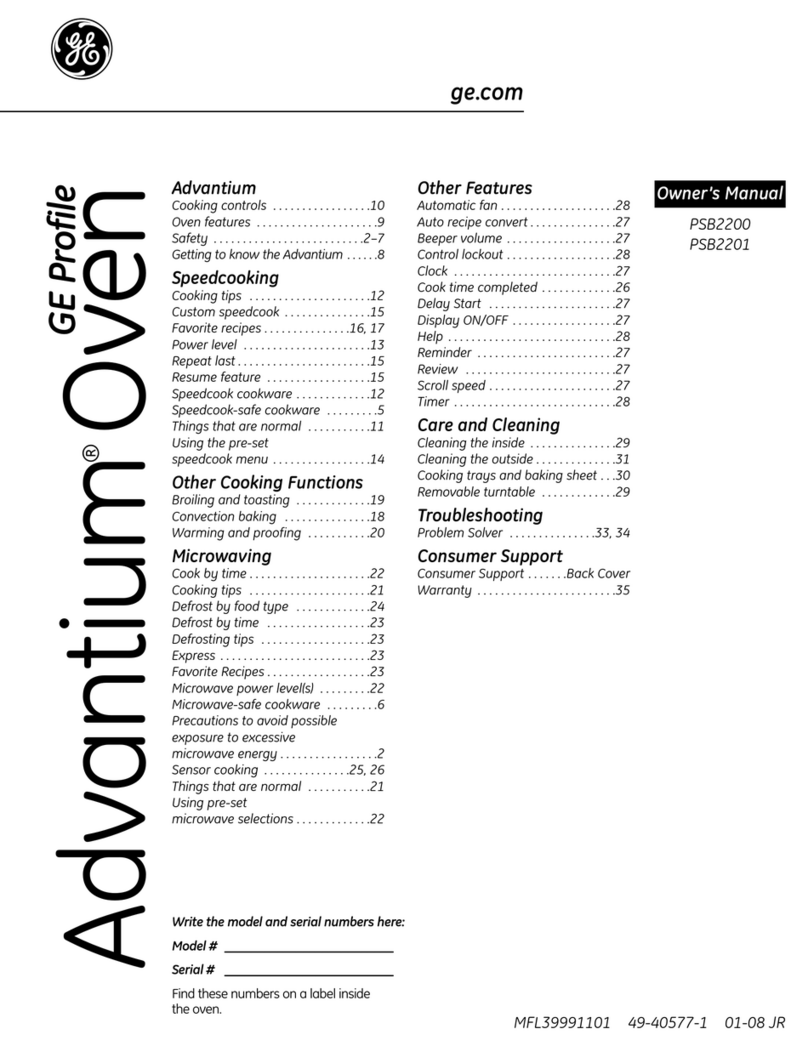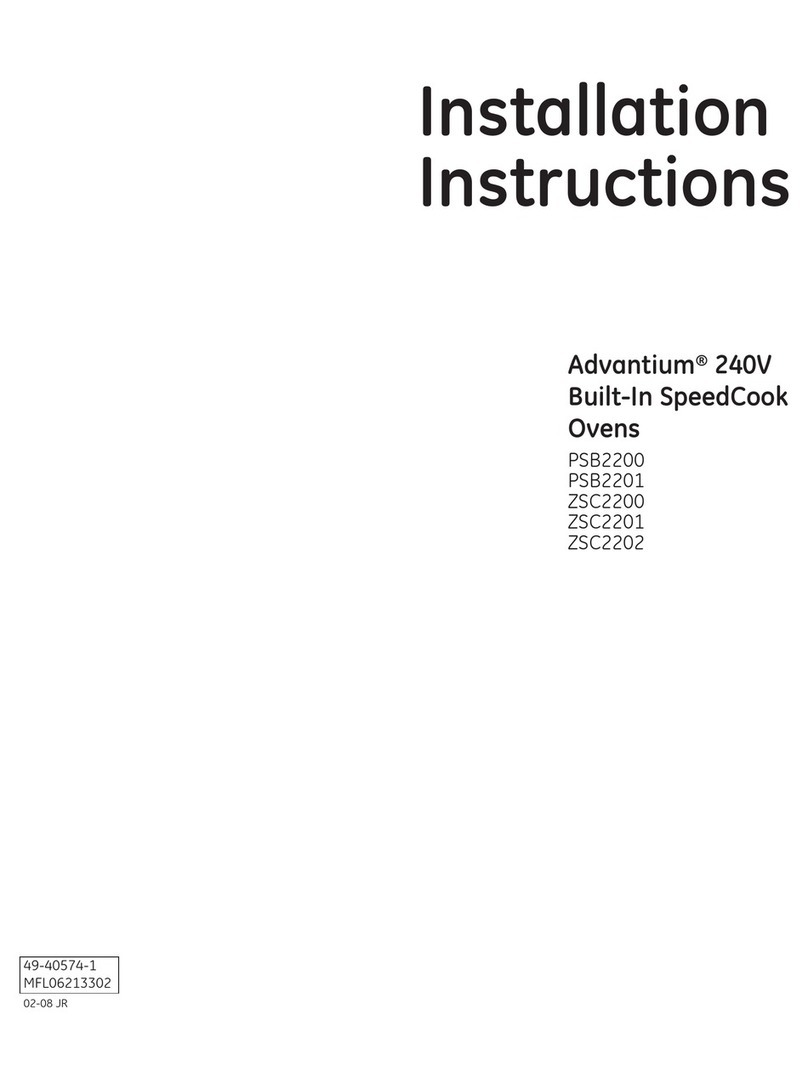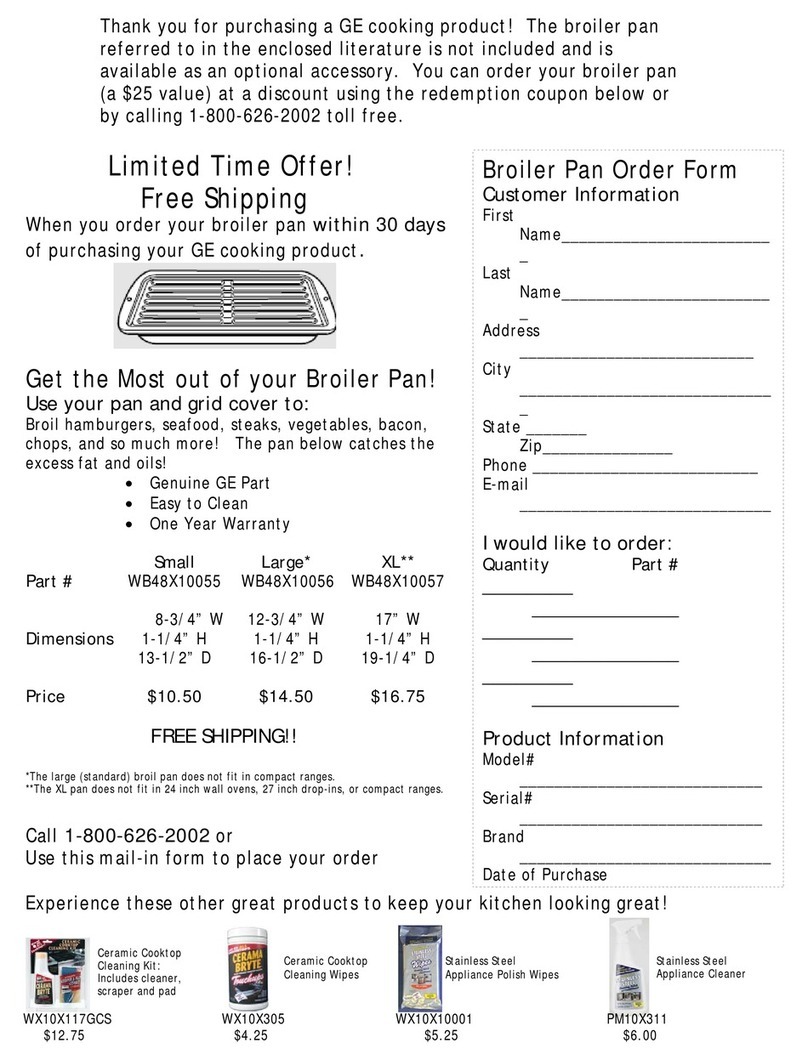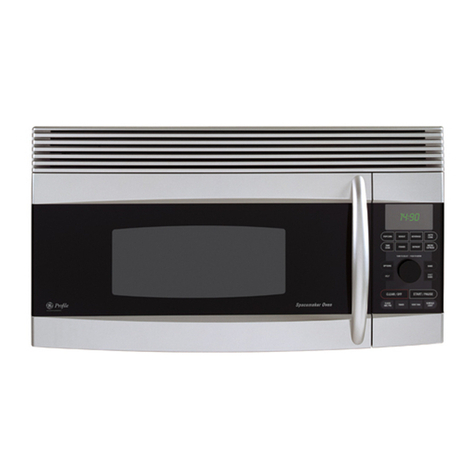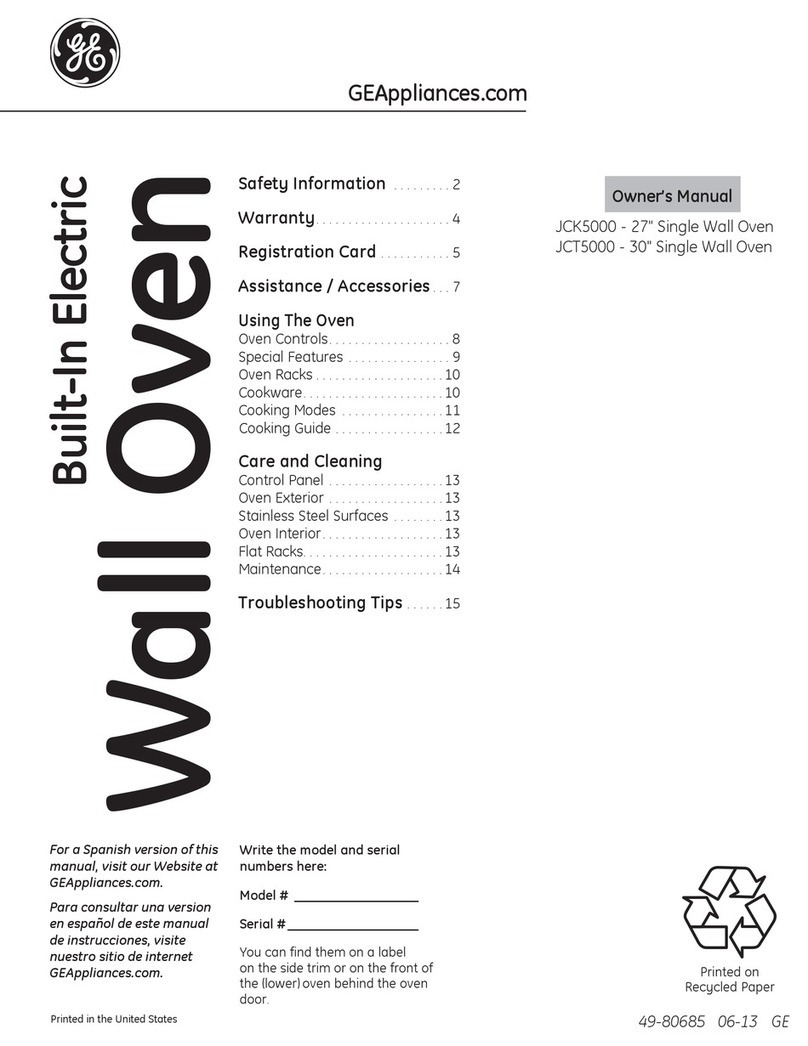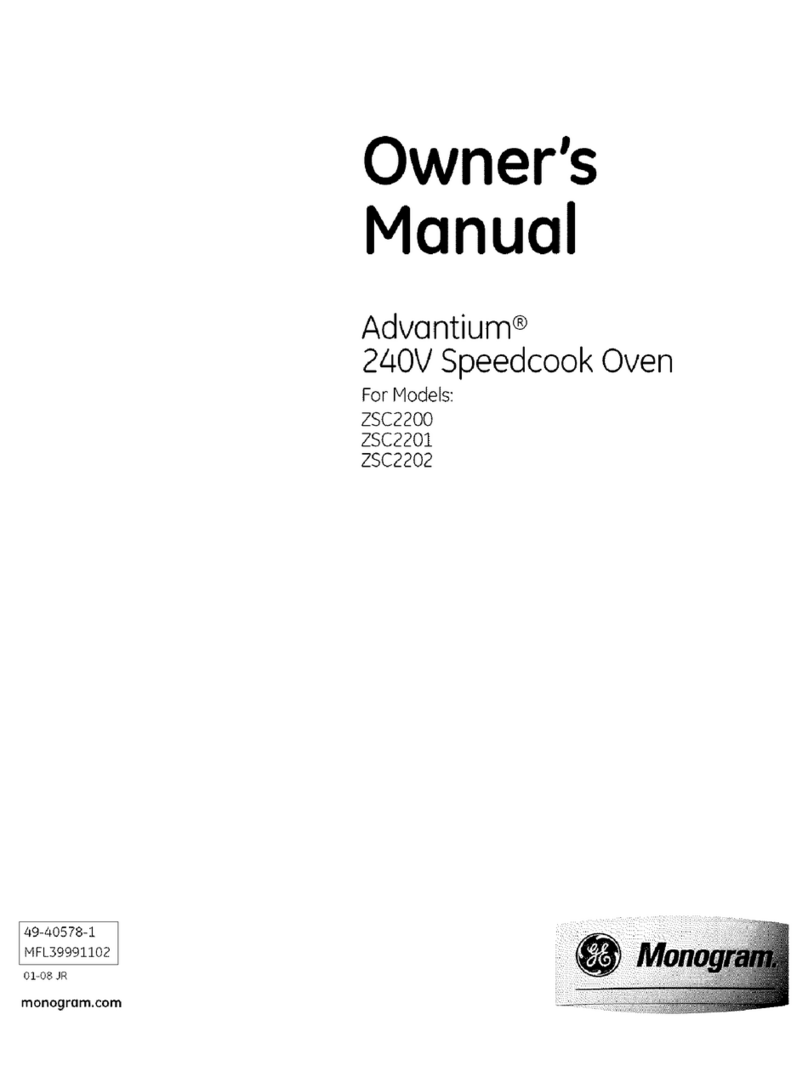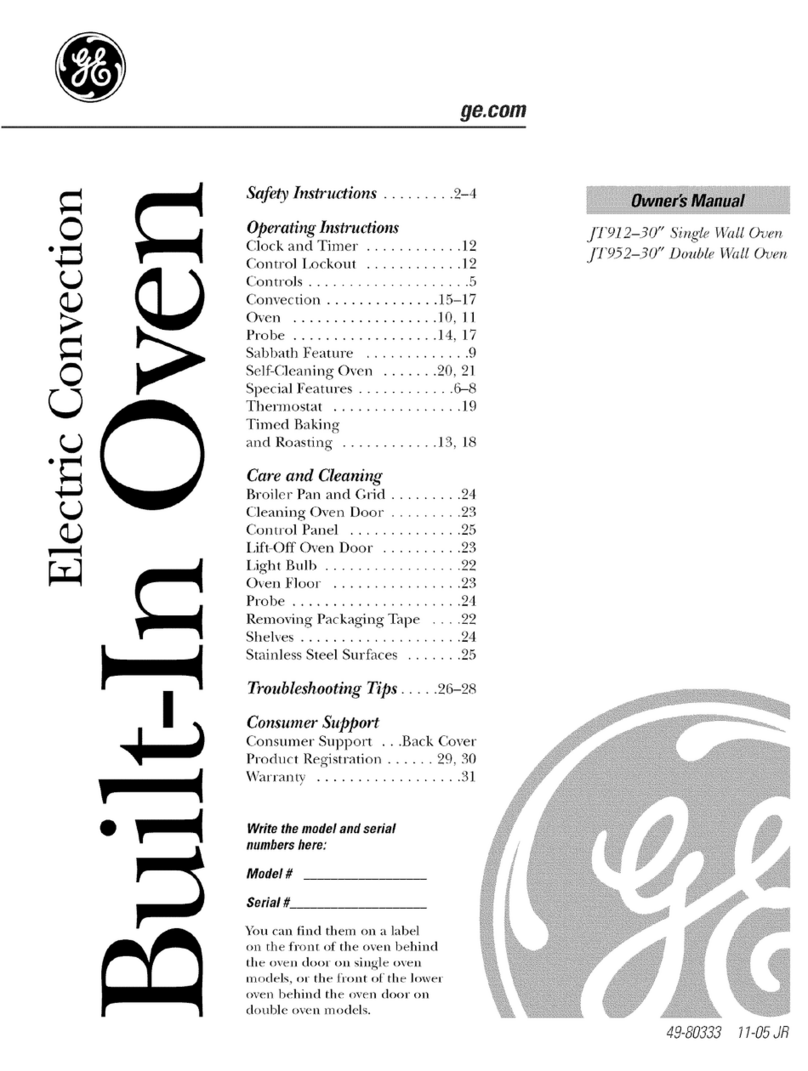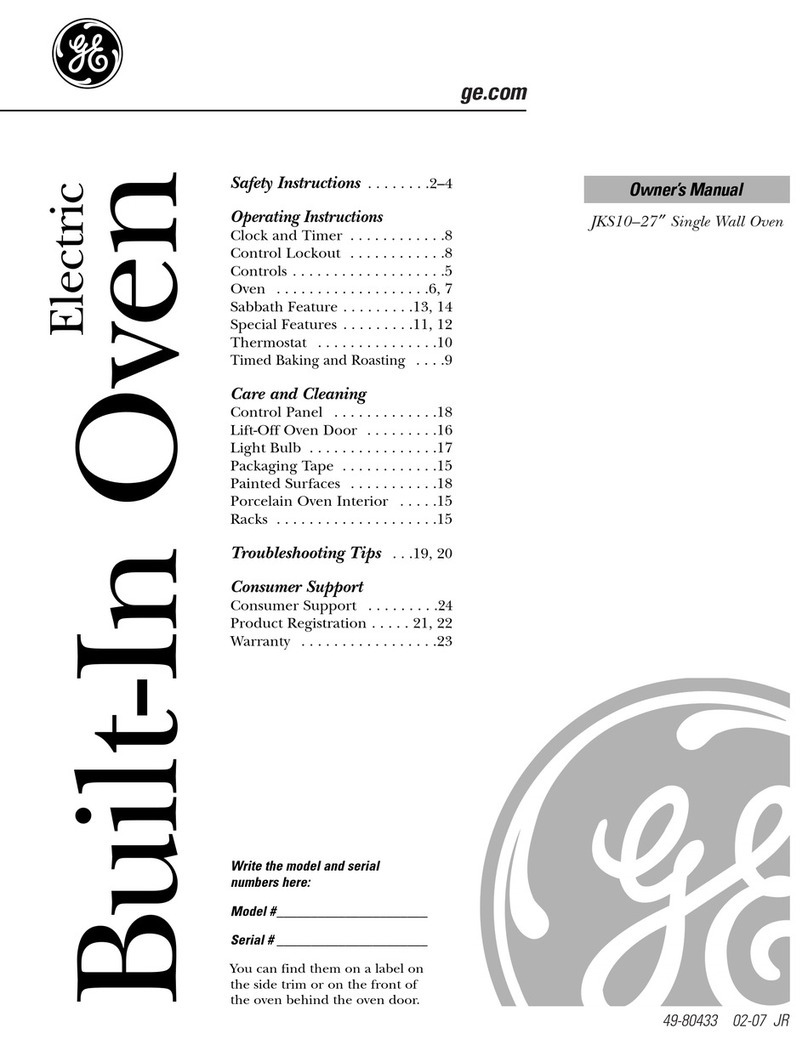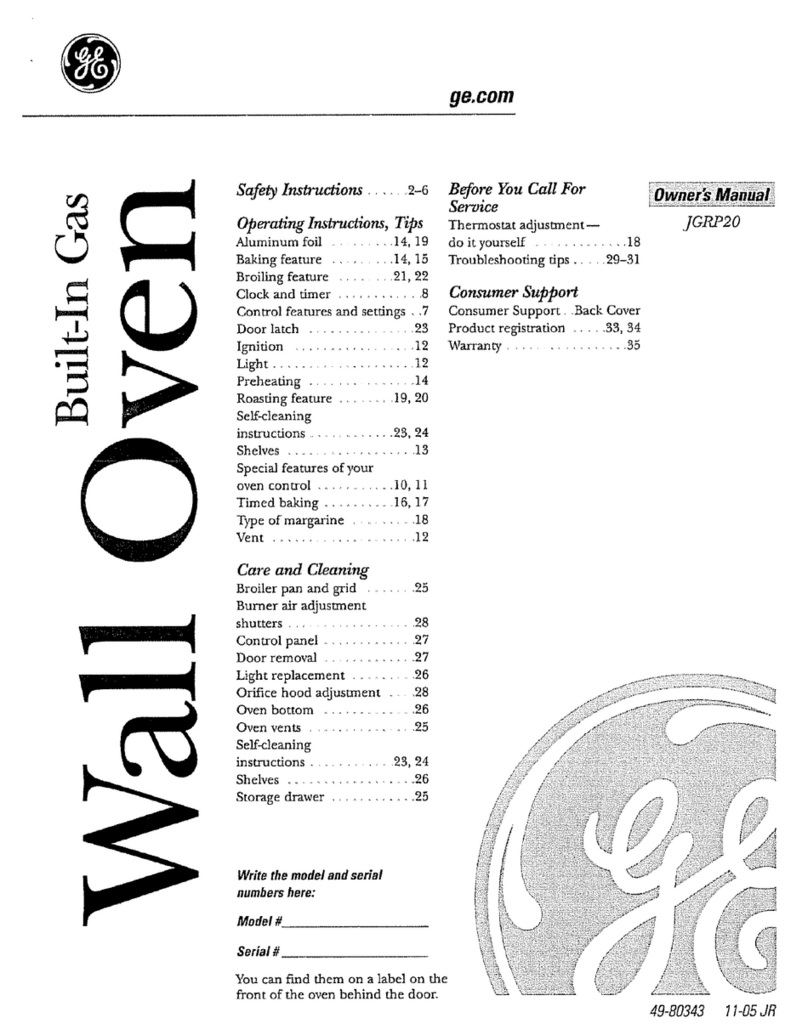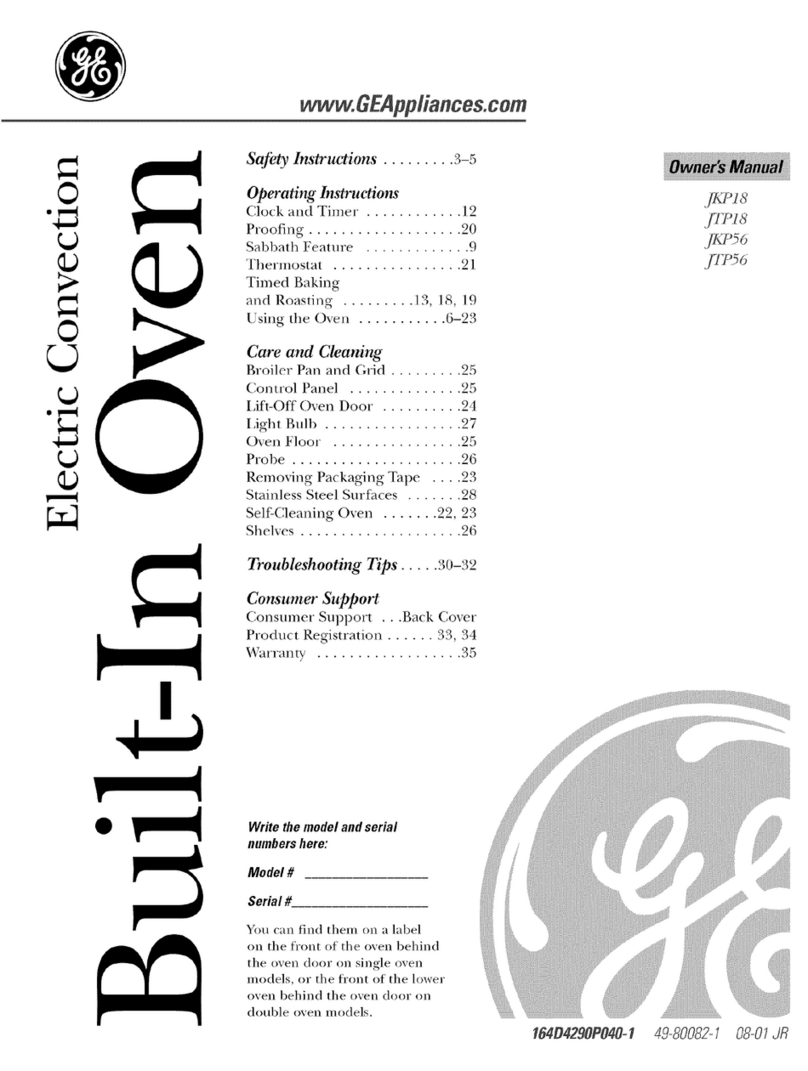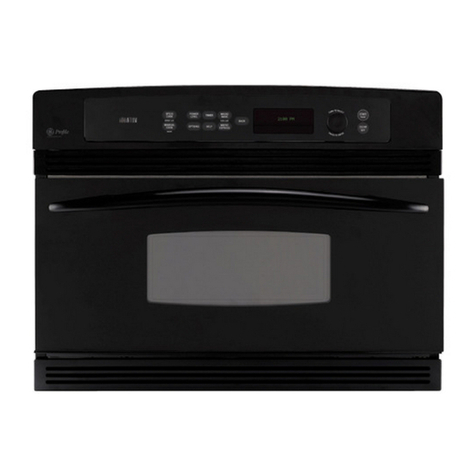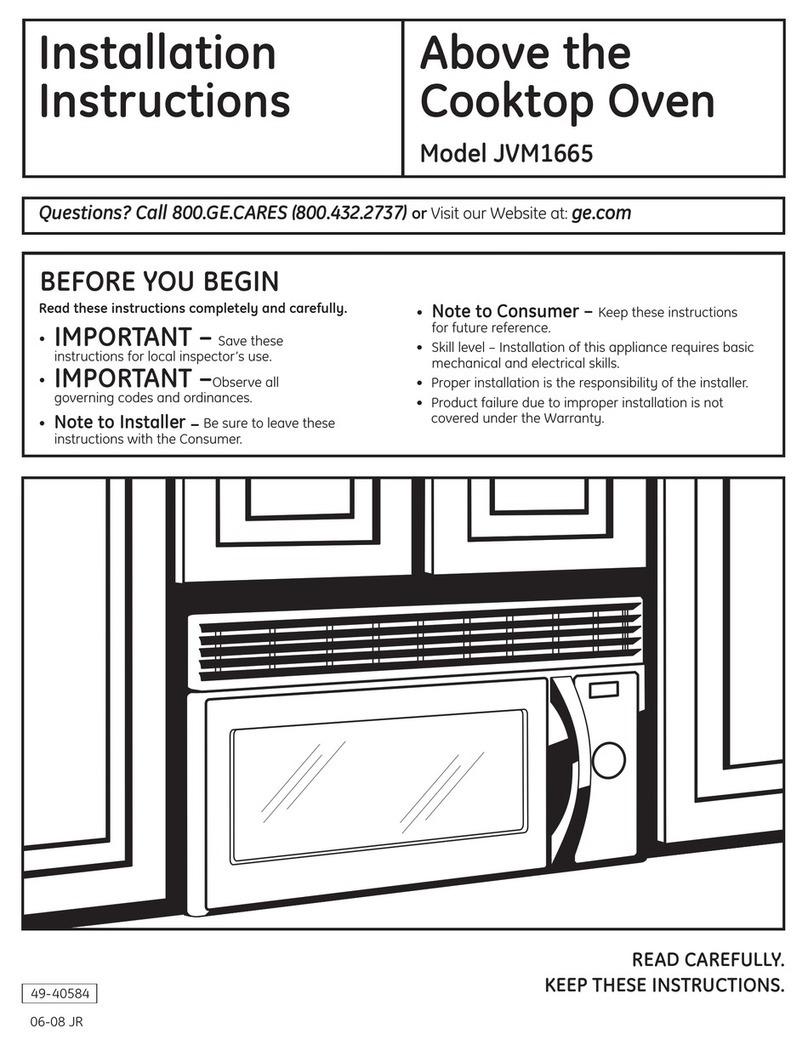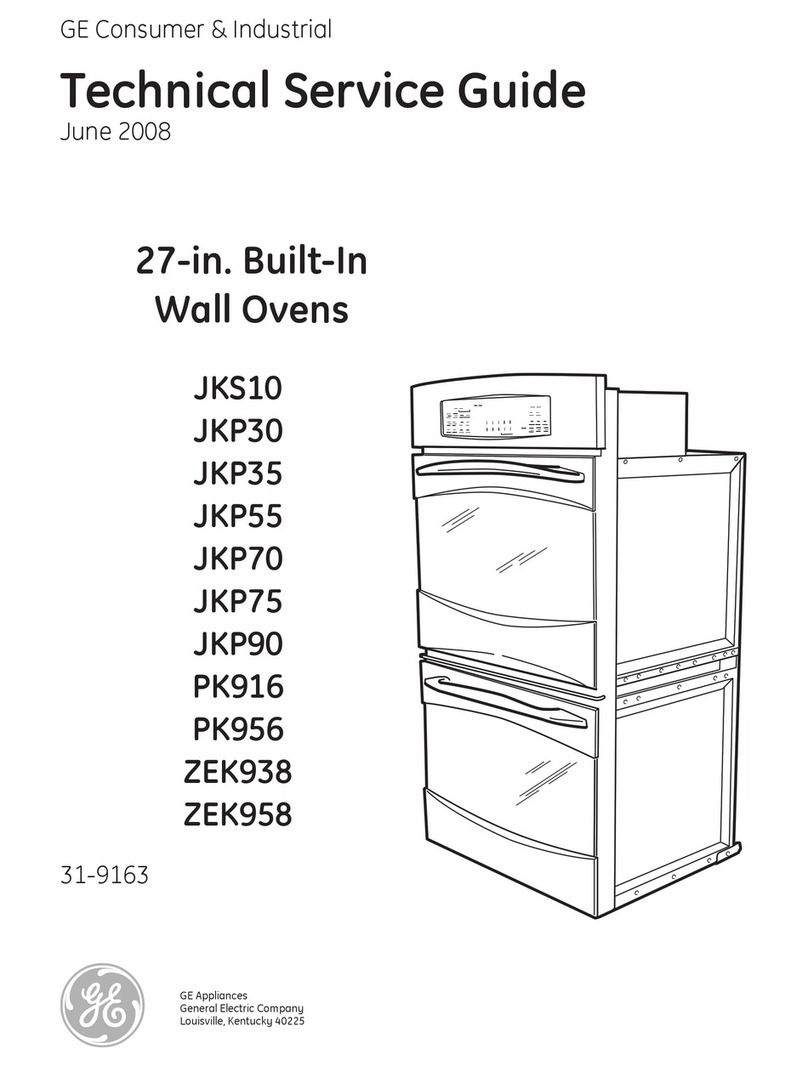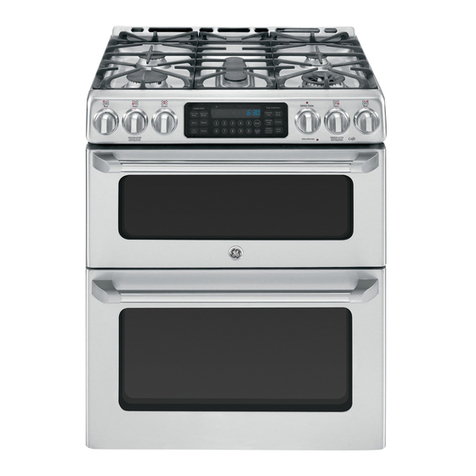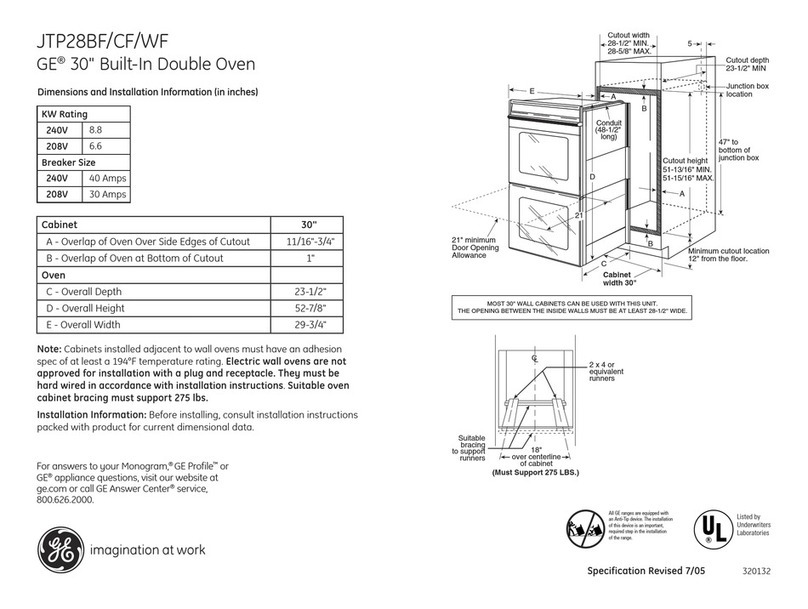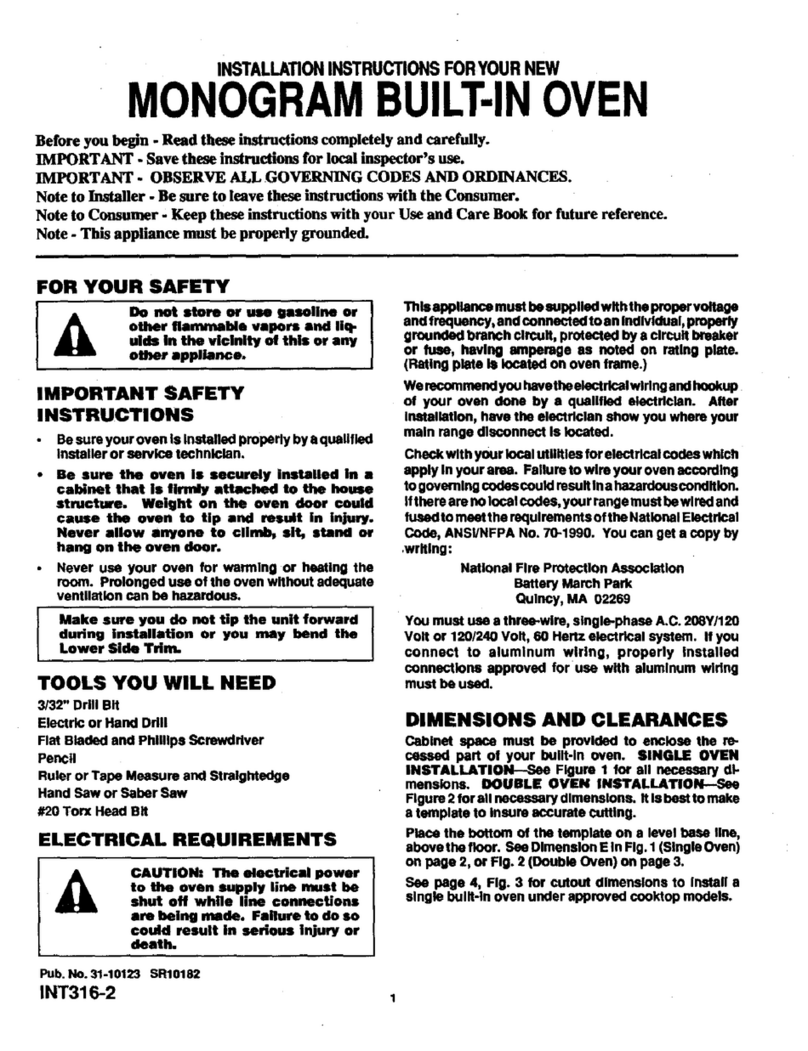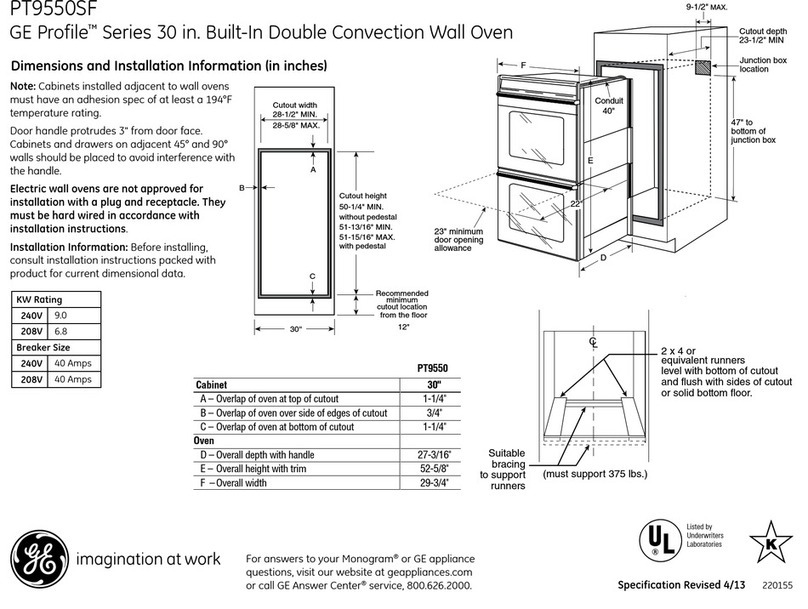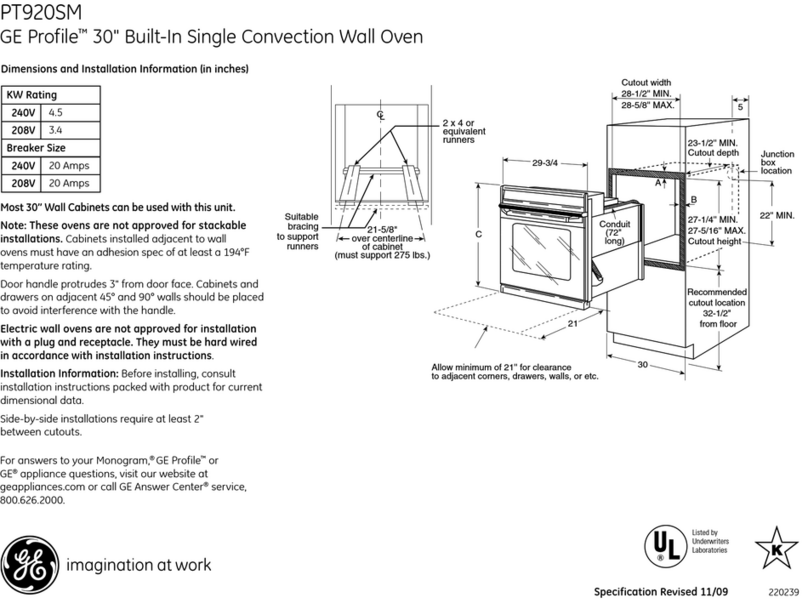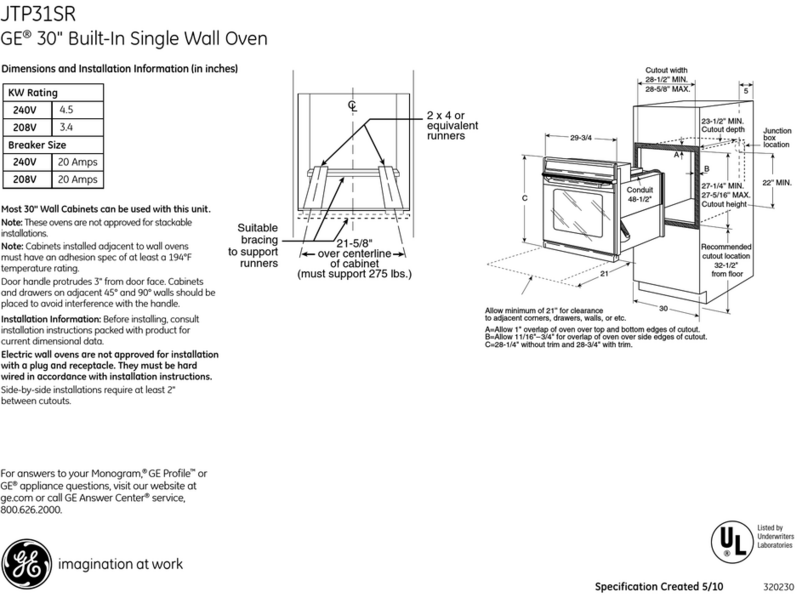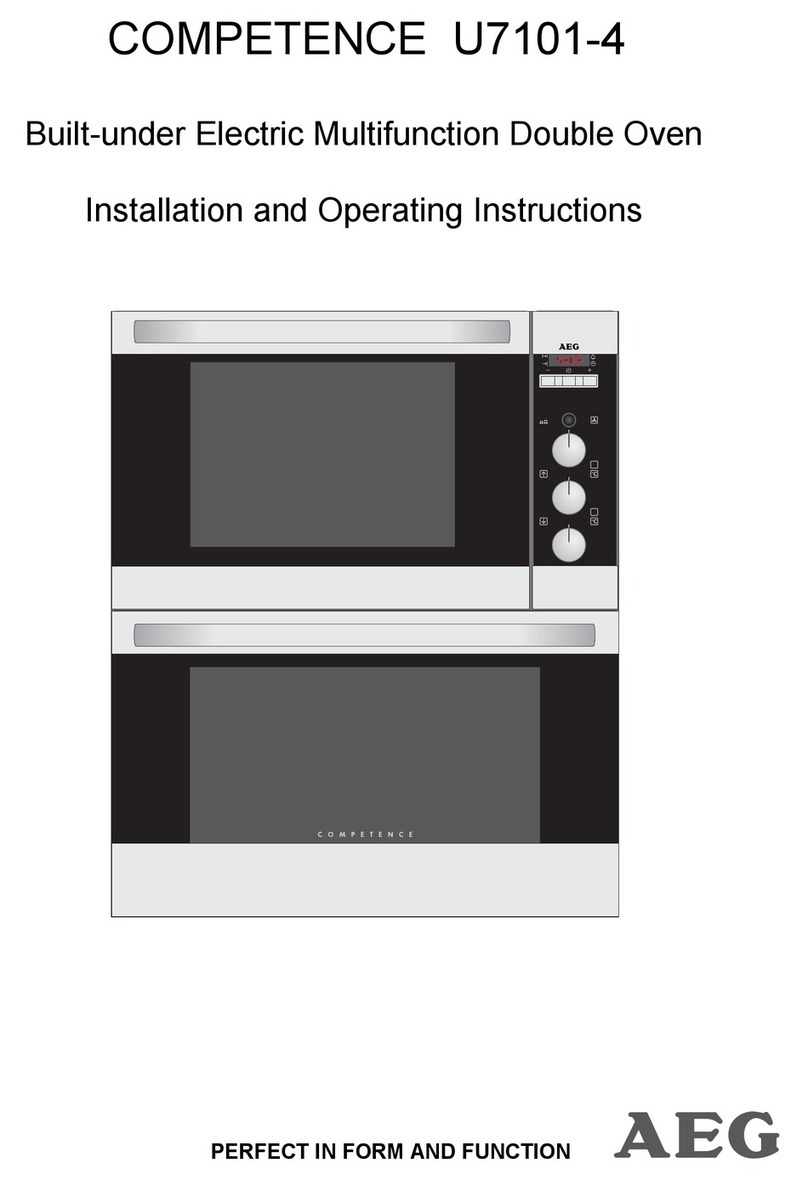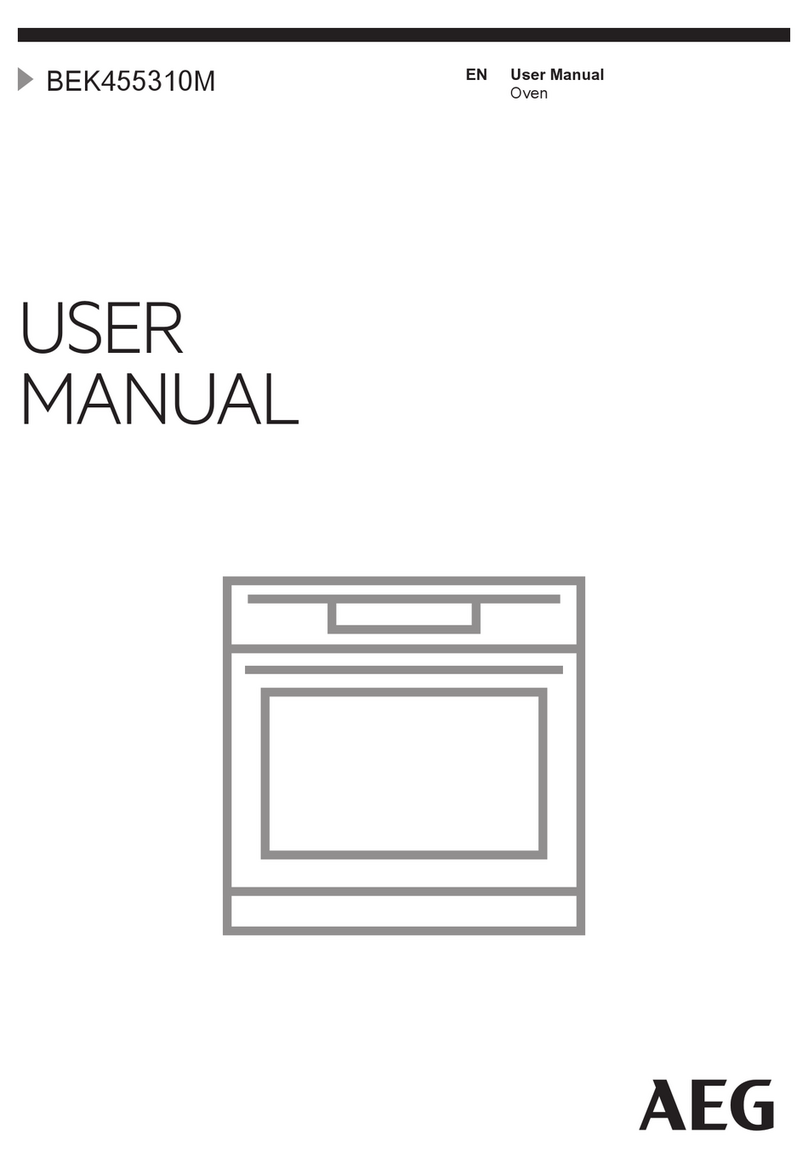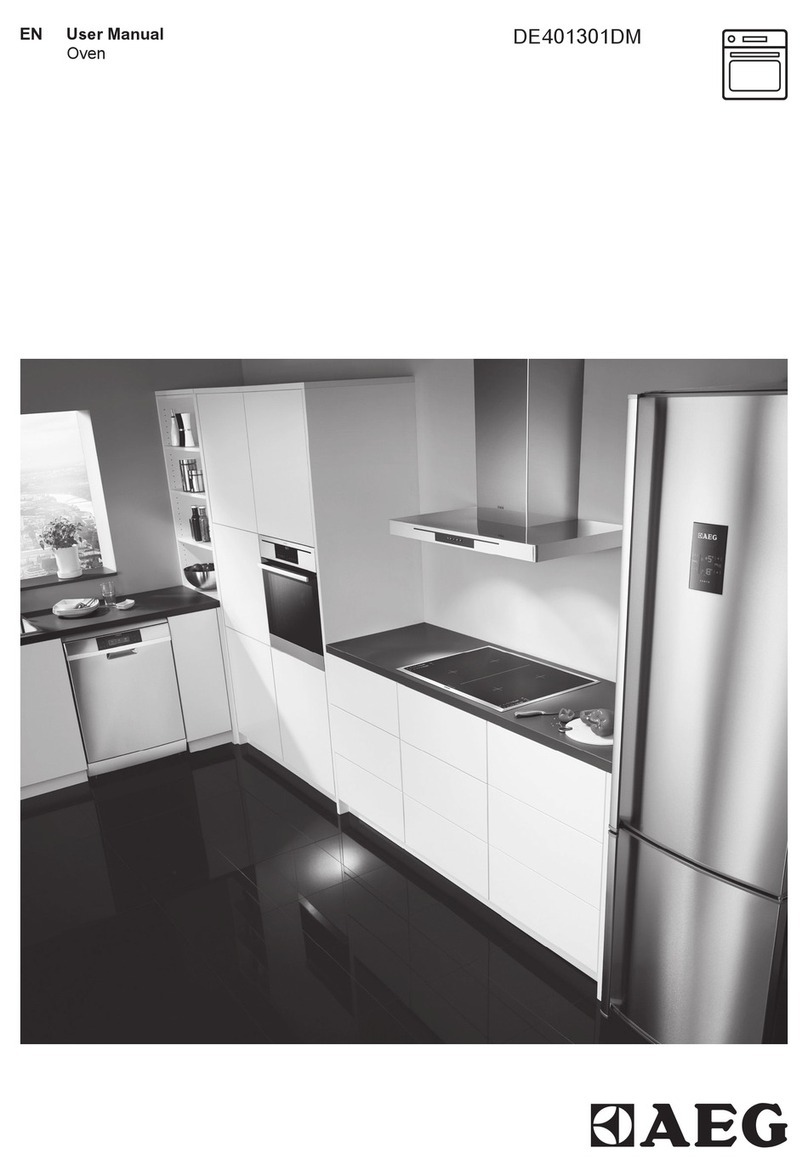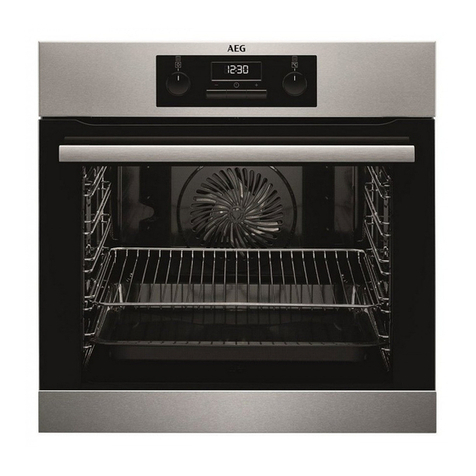DOOR REMOVAL (recommended)
NOTE: Door removal is not a requirement for installation of the product but is an added
convenience.
To remove the door:
A. Open the oven door as far as it will go.
B. Push both hinge locks down toward the door
frame to the unlocked position. This may require a
flat-blade screwdriver. DO NOT LIFT THE DOOR
BY THE HANDLE!
C. Place hands on both sides of the door
and close the oven door to the removal position
(approximately 1"–2" [2.5 cm–5.1 cm] from the
closed position).
D. Lift the door up and out until the hinge arms clear
the slots.
NOTE: The oven door is very heavy. Be sure
you have a firm grip before lifting the oven door off
the hinges. Use caution once the door is removed.
Do not lay the door on its handle.
This could cause dents or scratches.
3
ELECTRICAL REQUIREMENTS
WARNING
:
This appliance must be properly grounded.
WARNING
:
To prevent fire or shock, do not use an extension cord with this
appliance.
WARNING
:
To prevent shock, remove house fuse or open circuit breaker before
beginning installation.
WARNING
:
Improper connection of aluminum house wiring to copper leads can
result in an electrical hazard or fire. Use only connectors designed for joining copper to aluminum and
follow the manufacturer’s recommended procedure closely.
We recommend you have the electrical wiring and hookup of your appliance connected by a
qualified electrician. After installation, have the electrician show you how to disconnect power from
the appliance.
You must use a single-phase, 120/208 VAC or 120/240 VAC, 60 Hertz electrical system. If you
connect to aluminum wiring, properly installed connectors approved for use with aluminum wiring must
be used.
Effective January 1, 1996, the National Elec
trical Code requires that new construction (not existing)
utilize a four-conductor connection to an electric oven. When installing an electric oven in new
construction, a mobile home, recreational vehicle or an area where local codes prohibit grounding
through the neutral conductor, refer to the section on four-conductor branch circuit connections.
Check with your local utilities for electrical codes which apply in your area. Failure to wire your
oven according to governing codes could result in a hazardous condition. If there are no local
codes, your oven must be wired and fused to meet the National Electrical Code, NFPA No. 70 –
latest edition, available from the National Fire Protection Association.
4
ELECTRICAL REQUIREMENTS (CONT.)
This appliance must be supplied with the proper voltage and frequency and connected to an individual,
properly grounded branch circuit, protected by a circuit breaker or fuse. See the rating plate located on
the oven frame to determine the rating of the product.
Use the chart below to determine the minimum recommended dedicated circuit protection:
DO NOT shorten the flexible conduit. The conduit strain relief clamp must be securely attached
to the junction box and the flexible conduit must be securely attached to the clamp. If the flexible
conduit will not fit within the clamp, do not install the oven until a clamp of the proper size is obtained.
The 3 power leads supplied with this appliance are suitable for connection to heavier gauge household
wiring. The insulation of these 3 leads is rated for temperatures much higher than the temperature
rating of the household wiring. The current-carrying capacity of the conductor is governed by the wire
gauge and the temperature rating of the insulation around the wire.
4
Recommended
KW Rating KW Rating Circuit Size
240V 208V (Dedicated)
≤4.8 KW ≤4.1 KW 20 Amp
4.9 KW–7.2 KW 4.2 KW–6.2 KW 30 Amp
7.3 KW–9.6 KW 6.3 KW–8.3 KW 40 Amp
9.7 KW–12.0 KW 8.4 KW–10.4 KW 50 Amp
Rating plate is located on the oven side trim,
side front frame or lower front frame.
MOUNT THE OVEN
WARNING
:
Mounting screws
must be used. Failure to do so could result in the
oven falling out of the cabinet, causing serious injury.
NOTE: Before drilling the pilot holes, make sure
the oven is pushed as far back into the opening
as it will go and is centered.
NOTE: If the cabinet is particle board, you must
use #8 x ¾" particle board screws. These may
be purchased at any hardware store.
A. Drill through the mounting holes (top and
bottom) of the side trim for the #8 mounting
screws provided.
B. Secure the oven cabinet with the screws
provided.
9
BOTTOM TRIM INSTALLATION
A. With oven installed, take the bottom trim and
center it on the bottom front edge of the cabinet
opening.
B. Using the trim as a template, mark the center
of each slot (two total) where the mounting holes
will be drilled.
C. Remove the trim.
D. Drill pilot holes into the center of each template
mark.
E. Place the bottom metal trim centered over
the predrilled mounting holes. Tape the edges
of the trim down to maintain the alignment.
F. Using two trim screws provided, secure the bottom
trim to the bottom edge of the cabinet.
10
IMPORTANT: If this unit is ever removed from
the cabinet or the oven is ever pulled out for
service, the bottom trim must be removed first
or damage to the trim will occur.
REPLACING THE OVEN DOOR
NOTE: The oven door is heavy. You may need help lifting the door high
enough to slide it into the hinge slots. Do not lift the door by the handle.
A. Lift the oven door by grasping each side.
B. With the door at the same angle as the removal position (approximately
1"–2" [2.5 cm–5.1 cm] from the closed position), seat the notch of the
hinge arm into the bottom edge of the hinge slot. The notch of the hinge
arm must be fully seated into the bottom of the slot.
C. Fully open the door. If the door will not fully open, the indentation is not
seated correctly in the bottom edge of the slot.
D. Push the hinge locks up against the front frame of the oven cavity,
to the locked position.
E. Close the oven door.
11
FINAL INSTALLATION CHECKLIST
• Check to make sure the circuit breaker is closed (RESET) or the circuit fuses are replaced.
• Be sure power is in service to the building.
• Check that all packing material and tape have been removed. Failure to remove these materials
could result in damage to the appliance once the appliance has been turned on and surfaces
have heated.
• Remove all items from inside the oven.
• Check to be sure that the mounting screws are installed and flush with the side trim
(see Section 9).
• Check that the bottom trim is installed properly (see Section 10).
OPERATION CHECKLIST
• Turn on the power to the oven (refer to your Owner’s Manual). Verify that the bake and broil
units and all cooking functions operate properly.
• See your Owner’s Manual for the troubleshooting list.
• Be sure all of the oven controls are OFF before leaving the oven.
12
Hinge Slot
Hinge Arm
Hinge
Unlocked
Position
Hinge
Clears Slot
The Screws
Must Be a
Minimum of
1/4" (6 mm)
From the
Front of
the Cutout.
For 27" (68.6 cm)
Models with
Lower Trim in
Position, Mark (2)
Mounting Hole
Locations Here
Remove Lower
Trim Before
Predrilling
Mounting Holes
For 30" (76.2 cm)
Models with Lower
Trim in Position, Mark
(2) Mounting Hole
Locations Here
Trim Screw
Locations for 27"
(68.6 cm) Models
with Lower Trim
Side Trim
Metal Lower Trim
Side
Trim
Trim Screw Locations for 30" (76.2 cm)
Models with Lower Trim
Hinge in
Locked
Position
Notch of Hinge
Securely Fitted
Into Bottom of
Hinge Slot
Bottom
Edge of
Slot
Hinge
Arm
Hinge Notch
MAKE ELECTRICAL CONNECTIONS
WARNING
:
Switch power off at the service panel and lock the service
disconnecting means to prevent power from being switched on accidentally. When the service
disconnecting means cannot be locked, securely fasten a prominent warning device, such as a tag,
to the service panel.
Place oven on table or platform even with the cutout opening. For a single oven, the platform must
support 200 lbs. (91 kg); and for a double oven, the platform must support 375 lbs. (170 kg). Connect
the flexible conduit to the electrical junction box as shown below*. Position the conduit in such a
manner that it will lie on top of the oven in a natural loop when the oven is installed. You will need
to purchase an appropriate strain relief clamp to complete the connection of the conduit to the
junction box.
*Ovens come equipped with a 48" long conduit. If a longer conduit is desired, there may be one
available for your model. To check availability or order parts, call 1.800.GE.CARES.
5
THREE-CONDUCTOR BRANCH CIRCUIT CONNECTION
NOTE: If residence leads are aluminum conductors, see
WARNING in Section 4, Electrical Requirements.
When connecting to a three-conductor branch circuit, if local codes
permit:
A. Connect the bare oven ground conductor with the crimped
neutral (white) lead to the branch circuit neutral (white or gray
in color), using a wire nut.
B. Connect the oven red lead to the branch circuit red lead
and the oven black lead to the branch circuit black lead
in accordance with local codes, using wire nuts.
C. Install junction box cover.
6
Junction Box
Conduit
Bare
Ground Red
White
Black
Strain Relief Clamp
(not included) Must
Be Used at Junction
Box
Place Oven on a
Support to Assist in
Connecting Conduit
Ground
and Neutral
Wires
Junction
Box Cover
Ground
Wire
FOUR-CONDUCTOR BRANCH CIRCUIT CONNECTION
NOTE: If residence leads are aluminum conductors, see WARNING in Section 4, Electrical
Requirements.
A. Cut the neutral (white) lead from the crimp. Re-strip the neutral (white) lead to expose
the proper length of conductor.
B. Attach the appliance grounding lead (green or bare copper)
in accordance with local codes. If the residence grounding
conductor is aluminum, see WARNING in Section 4.
C. Connect the oven neutral (white) lead to the branch circuit
neutral (white or gray) in accordance with local codes, using
a wire nut.
D. Connect the oven red lead to the branch circuit red lead
and the oven black lead to the branch circuit black lead
in accordance with local codes, using wire nuts.
NOTE: If the residence red, black or white leads are aluminum
conductors, see WARNING in Section 4.
E. Install junction box cover.
7
SLIDE OVEN INTO OPENING
A. Loop (do not tie) a 36” (91 cm) string around the conduit before the oven is slid into place.
This will keep the conduit from falling behind the oven.
B. Lift oven into cabinet cutout
using the oven opening as a
grip. Carefully push against
oven front frame. Do not push
against outside edges.
C. As you slide the oven back,
pull the string so that the
conduit will lie on top of the
oven in a natural loop.
D. When you are sure the
conduit is out of the way, slide
the oven ¾ way back into the
opening. Remove the string
by pulling on one end of the
loop.
8
